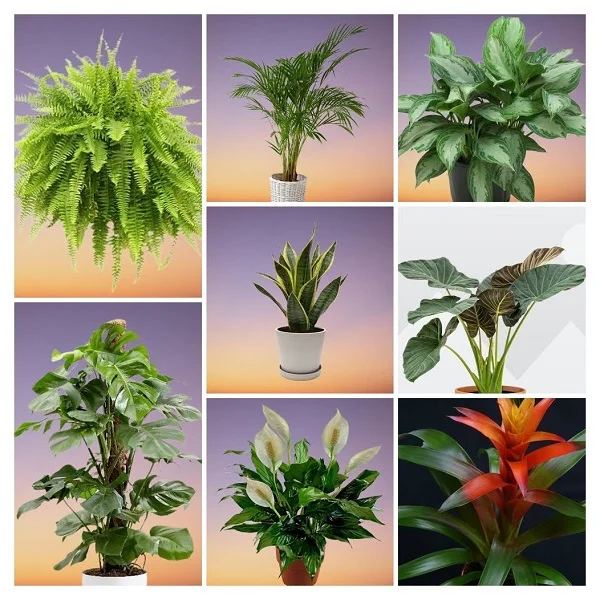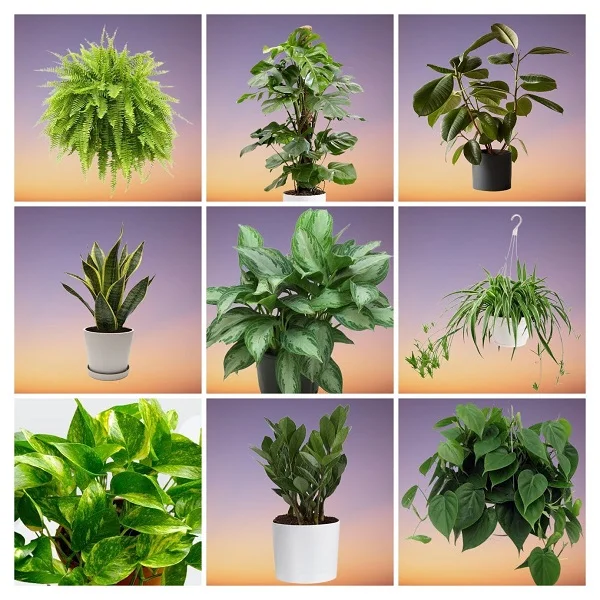Schefflera actinophylla (Umbrella Tree) Indoor Care and Commom Problems with Remedies
Some links in this post may be affiliate links
Umbrella Tree (Schefflera actinophylla) grows best in bright indirect light, moderate warmth, average humidity and moderately moist, rich, well-drained soil coupled with monthly feeding in the growing season.
Before we get into care tips, let’s take a closer look at this beautiful plant. Schefflera actinophylla also called Octopus Tree, Australia Umbrella Tree, Queensland Umbrella or Amate is one of the popular tree-like plants ideal for the large spaces in the home, office and other suitable places.
Umbrella Tree gets its common name, 'umbrella Tree', from its large finger-like glossy leaflets radiating like umbrella spokes. The common name, 'Octopus Tree', is because of its spectacular, red-colored, tentacle-like flowers.
As the plant ages, it loses its lower leaves and therefore becomes leggy. Cut it back harshly to stimulate new growth and pinch off the growing tips to encourage a compact and bushy growth.
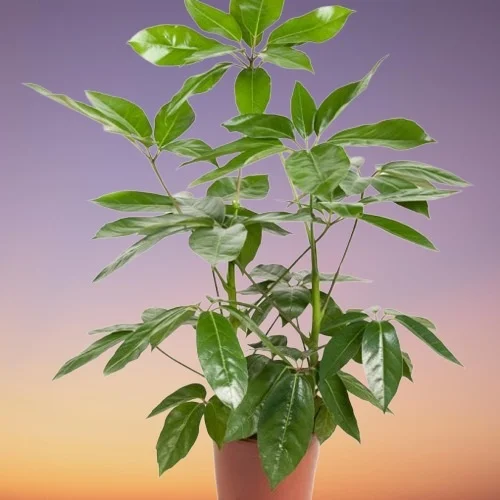
Botanical name: Schefflera actinophylla
Synonmy: Heptapleurum actinophyllum
Family: Araliaceae
Common names: Umbrella Tree, Octopus Tree, Australia Umbrella Tree, Queensland Umbrella, Amate
Origin
Schefflera actinophylla also called Heptapleurum actinophyllum is native to tropical rainforests in nothern and north-eastern Queensland coasts, Northern Australia, New Guinea and Java.
The common name, 'Queensland Umbrella', is due to its origins in the Queensland Coasts while the name, 'Australia Umbrella Tree', is due to its origins in Northern Australia.
Size
Octopus Tree can grow to a height of 6-8 feet placing it among the bold statement plants which create a great first impression in any space.
Related Plants
Australia Umbrella Tree is closely related to Schefflera arboricola (Dwarf Umbrella Tree), which is a more compact and smaller version of Umbrella Tree.
Toxicity
Umbrella Tree is toxic to both humans and pets as indicated by ASPCA. It contains "sharp" calcium oxalate crystals which are insoluble and damage cells and tissues of animals if ingested. They cause swelling of the exposed tissue and the digestive tract which may be fatal to both animals and humans.
Where to Buy
Umbrella Trees are a great addition to any plant collection. You may obtain these plants online from Etsy (Link to Etsy).
Schefflera actinophylla Care Indoors
Unlike fussy houseplants, Schefflera adapts well to indoor conditions. But how do you keep your Schefflera thriving indoors? Whether you're new to houseplants or looking to refine your care routine, this guide will cover everything you need to know—from light, watering needs, feeding to common problems and solutions.
Umbrella Tree (Schefflera actinophylla) performs best in bright indirect light (filtered light), average warmth of 15-280C, humidity of 50-55% and moderately moist, rich, well-drained, all purpose soil coupled with monthly feeding during the growing season.
Schefflera actinophylla requires repotting every 2 years only when it becomes pot-bound. Regular pruning is necessary to keep the plant neat, to minimize pest and disease infestation and to encourage a bushy, compact growth. Keep reading for more on these growing conditions and how to achieve them.
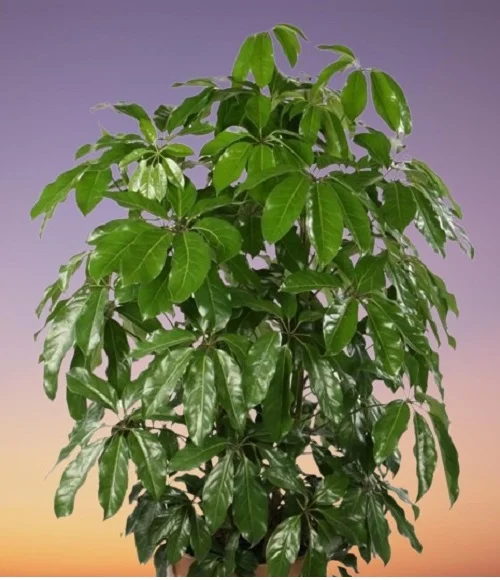
Light Requirements
Umbrella Tree grows best in bright indirect light. Keep it away from direct sunshine to prevent sun burn on the leaves. It can also tolerate some shade but the growth will be much slower.
Octopus Tree will also thrive under a grow light where the natural lighting is not sufficient. Take a look at these full spectrum grow lights on Amazon.
Regularly rotate the pot to ensure that the plant receives light on all sides for uniform growth to prevent lop-sided growth.
Watering
Water your Umbrella Tree liberally during the growing season and allow the top 2-3 inches of soil to dry out between waterings to maintain the soil moderately moist.
Decrease watering in the cold season to maintain the soil slightly moist as growth is minimal at this time but do not allow the soil to dry out completely.
Make sure that the pot has a drainage hole to prevent the soil from getting soggy as it can lead in root-rot and the death of the plant.
Temperature and Humidity
The best temperature for growing Umbrella Tree indoors is an average warmth of 15-280C. Keep it away from cold drafts to avoid sudden drop in temperature as it can cause leaf drop.
Normal household humidity of 50-55% is ideal for Umbrella Tree; normally it has no need for extra humidity. However, when the indoor temperatures a very high which significantly reduce air humidity, set the pot on a wet pebble tray or use a cool mist humidifier to raise humidity.
Mist the leaves regularly and clean them by damp-wiping with a soft cloth to get rid of dust and to keep them shiny. Make sure that there is good ventilation to minimize fungal infestations.
Fertilizer
Feed Umbrella Tree with a balanced, liquid fertilizer every 4 weeks during the growing period for lush growth. Do not feed in the cold season as growth is minimal and feeding at this time may lead to fertilizer burn.
Flush out accumulated salts from the soil regularly by running a stream of water through the soil until the water comes out through the drainage hole. Allow it to run for a few minutes and repeat several times.
Potting Mix
The best soil for Umbrella Tree should be rich in organic matter and free-draining to prevent it from getting soggy while providing the required nutrients. All purpose potting mixes are ideal for this plant.
Repotting
Repot Umbrella Tree every 2 years during the growing season when the plant becomes root-bound. A pot 1 size larger than the current one is ideal as it prefers to be root-bound.
Ensure that the pot has a drainage hole as the plant does not like to be in soggy soil and it can lead to root-rot. The plant can get top-heavy therefore use a heavy pot to prevent it from toppling over.
A large plant that may be difficult to repot, replace the top 2-4 inches of soil with fresh soil annually. Check out these ceramic pots on Amazon.
Pruning
Pruning Umbrella Tree requires removal of dead and yellow leaves to maintain the plant neat as well as discourage pest and disease infestations. To encourage a bushy and compact growth, regularly pinch the growing tips and new growth will appear just below the cut.
If the plant becomes leggy, cut it back with a sharp, clean pair of pruning scissors to the desired height to encourage new growth to sprout below the cut. The foliage emanating from the pruning can be used for taking cuttings to propagate new plants.
Propagation
Umbrella Tree (Schefflera actinophylla) can be propagated during the growing season from stem cuttings, stem-tip cuttings or by air-layering.
Read more on these 3 Ways to Propagate Umbrella Tree (Schefflera actinophylla).
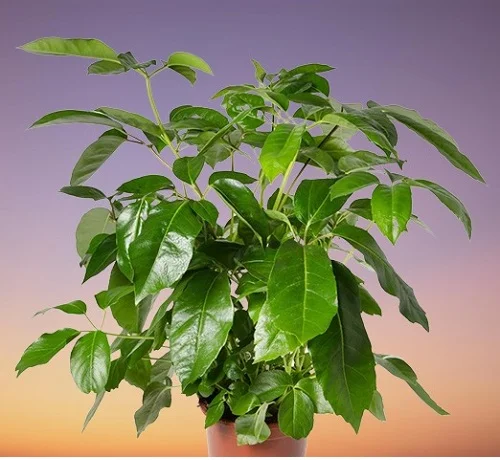
Schefflera actinophylla Problems
Umbrella Tree (Schefflera actinophylla) growing problems include yellow leaves, pale colored leaves, leggy growth, leaf drop, drooping leaves, pests and diseases among others. Keep reading for more on these problems and how to solve them.
Pale colored young leaves
Pale young leaves in Umbrella Tree are due to underfeeding (inadequate feeding). The tree requires to be adequately provided with the necessary nutrients to thrive.
Feed the plant with abalanced, liquid fertilizer every 4 weeks during the growing period. do not feed it in the cold season to prevent fertilizer burn as growth is minimal at this time. Learn more on how to feed houseplants.
Pests
Common pests in Umbrella Tree are scale insects, mealy bugs and spider mites. Isolate the affected plant to prevent spread to other plants and treat for the pests. Mist and clean the leaves regularly to discourage the pests infestations and also get rid of dust. Learn how to identify and get rid of pests in houseplants.
Diseases
The most common disease in Umbrella Tree is root-rot which is brought about by soggy soil due to poor soil drainage. The disease is indicated by yellowing of leaves, stems turning brown-black and gradual wilting of the plant. Isolate the affected plant to prevent spread to other plants and treat it for the disease.
Drooping leaves
Drooping leaves in Umbrella Tree are due to underwatering that is too little moisture in the soil. This means that the plant is losing more water than is available in the soil for uptake.
Water the plant thoroughly during the growing season and maintain the soil moderately moist. Decrease watering in the cold season to keep the soil slightly moist but never allow the soil to dry out completely. Read more on how to water houseplants correctly.
Leggy growth, undersized yellow leaves
Leggy growth and undersized yellow leaves in Umbrella Tree are due to too little light. Move the plant to a brighter spot where it will receive bright indirect light or instal grow lights where the natural light is not enough. Check out this post on understanding light for houseplants.
Yellow leaves
Umbrella Tree yellow leaves are caused by overwatering or too wet soil (soggy soil). Ensure that both the soil and the pot have adequate drainage to prevent unhealthy water retention in the soil.
Dropping leaves (leaf drop)
Leaf drop in Umbrella Tree is brought about by sudden change in growing conditions due to drafts or moving the plant suddenly before acclimating it to the new growing conditions.
The plant needs to be slowly acclimated to the new growing conditions before moving it. Also keep the plant away from drafts from windy doors and windows, hot air vents, hot surfaces, air conditioning units and others to avoid sudden changes in temperature.
Final thoughts
Schefflera actinophylla, commonly known as the Umbrella Tree, is a stunning and resilient indoor plant. It is a favorite among houseplant enthusiasts.
However, to keep this plant thriving, you must understand its specific care requirements and potential problems. Keep your plant happy by balancing light, water, and humidity—these three factors make all the difference!
You liked it? Share on social media.
Related Content
Amazon Associates Disclosure
Homeplantsguide.com is a participant in the Amazon Services LLC Associates Program, an affiliate advertising program designed to provide a means for sites to earn advertising fees by advertising and linking to amazon.com.



